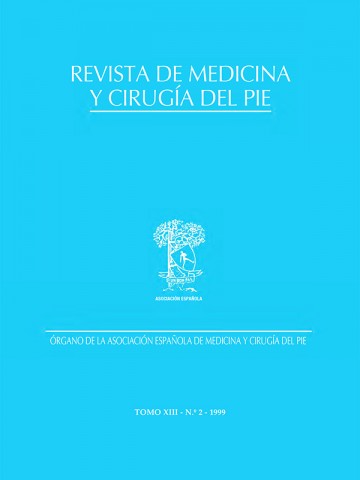Resumen:
La patología del antepié está relacionada, a menudo, con la utilización del calzado, por lo que interesa conocer cómo influyen en él los distintos tipos. El objetivo de este trabajo ha sido analizar las variaciones de las presiones y de su distribución a nivel de la paleta metatarsiana con la utilización de los calzaáos que se utilizan más frecuentemente, deportivos (calzado blando) y zapatos de suela de cuero (calzado duro), de forma que se pueda aconsejar sobre su uso en condiciones normales, según la actividad a realizar, o en sujetos con determinadas patologías.
Material y métodos: el estudio se realizó a 43 sujetos (20 hombres y 23 mujeres) a los que se realizó un registro de las presiones, mediante el sistema PDM 240, a nivel de las 5 cabezas metatarsianas, mientras caminaban a su velocidad normal, con calzado duro y, posteriormente, con blando. Los datos que se valoraron fueron las presiones máximas registradas en dichos puntos y su distribución, es decir, lo que representaban porcentualmente dichas presiones respecto al total del antepié en el momento en que se producían.
Resultados: en el antepié, las mayores presiones a lo largo de todo el ciclo de la marcha se soportan en las cabezas del 2.° y 3.° metatarsiano, seguidos muy de cerca por la del primero. La distribución de las presiones entre las 5 cabezas metatarsianas no varía con la utilización de los dos tipos de calzado estudiados, pero con el blando son entre un 12 y un 25% menores que con el duro.
Abstract:
The pathology of the forefoot is related, often, to the utilization of the footwear, therefore interests to know how influence him the different types. The objective of this work has been analyzed the variations of the pressures and of its distribution at level of the metatarsal palette with the utilization of the footwear that are used more frequently, sports (soft footwear) and shoes of leather sole (hard footwear), so that could be advised on íts use in normal conditions, according to the activity to accomplish, or in subject with given pathologies.
Material and methods: The study was accomplished to 43 subject (20 men and 23 women) to those which was accomplished a record of the pressures, through the system PDM 240, at level of 5 heads metatarsals, while were walking to their normal speed, with hard footwear and, thereafter, with soft. The data that were valued were the maximum pressures registered in said points and its distribution, that is to say, what were representing a percentage of such respect pressures to the total of the forefoot in the moment in which was produced.
Results: In the forefoot, the greater pressures throughout all the cycle of the march are sustained in the heads of the 2.ºº and 3.º metatarsal, followed very of near by that of first. The distribution of the pressures between 5 heads metatarsals does not vary with the utilization of the two types of studied footwear, but with the soft are between a 12 and a 25% less than with the hard.





